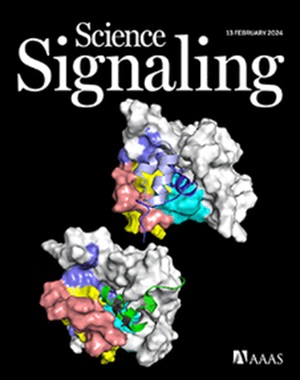An in vivo screen identifies diverse domains that can act as force-dependent proteolytic switches for Notch activation
IF 6.6
1区 生物学
Q1 BIOCHEMISTRY & MOLECULAR BIOLOGY
引用次数: 0
Abstract
Notch proteins are single-pass transmembrane receptors activated by sequential extracellular and intramembrane cleavages to release the cytosolic domains that function as transcription factors. Transmembrane ligands of the Delta/Serrate/LAG-2 (DSL) family activate Notch on neighboring cells by exerting a pulling force across the intercellular ligand-receptor bridge. This force is generated by Epsin-mediated endocytosis of the ligand into the signal-sending cell and results in the extracellular cleavage of the force-sensing negative regulatory region (NRR) of the receptor by an ADAM10 protease on the signal-receiving cell. Here, we used chimeric Notch and DSL proteins to screen for other domains that could function as ligand-dependent proteolytic switches in place of the NRR in the developing Drosophila melanogaster wing. The domains that could functionally substitute for the NRR in vivo derived from diverse source proteins, varied in sequence, and had different predicted structures, yet all depended on cleavage that was catalyzed by the Drosophila ADAM10 homolog Kuzbanian (Kuz) and stimulated by Epsin-mediated ligand endocytosis. The large sequence space of protein domains that can serve as force-sensing proteolytic switches suggests a widespread potential role for force-dependent, ADAM10-mediated proteolysis in other cell contact–dependent signaling mechanisms.

体内筛选确定了不同的结构域,这些结构域可以作为Notch激活的力依赖性蛋白水解开关
Notch蛋白是一种单通道跨膜受体,通过连续的细胞外和膜内裂解激活,释放作为转录因子功能的细胞质结构域。Delta/Serrate/LAG-2 (DSL)家族的跨膜配体通过在细胞间配体-受体桥上施加拉力激活邻近细胞上的Notch。这种力是由eptin介导的配体内吞作用产生的,进入信号发送细胞,并导致信号接收细胞上的ADAM10蛋白酶在细胞外切割受体的力感应负调节区(NRR)。在这里,我们使用嵌合的Notch和DSL蛋白来筛选其他可能在发育中的果蝇翅膀中代替NRR作为配体依赖性蛋白水解开关的结构域。在体内能够在功能上替代NRR的结构域来自不同的来源蛋白,序列不同,具有不同的预测结构,但都依赖于由果蝇ADAM10同源库兹虫(Kuzbanian)催化的裂解,并由eptin介导的配体内吞作用刺激。可以作为力传感蛋白水解开关的蛋白质结构域的大序列空间表明,在其他细胞接触依赖的信号机制中,力依赖的adam10介导的蛋白水解具有广泛的潜在作用。
本文章由计算机程序翻译,如有差异,请以英文原文为准。
求助全文
约1分钟内获得全文
求助全文
来源期刊

Science Signaling
BIOCHEMISTRY & MOLECULAR BIOLOGY-CELL BIOLOGY
CiteScore
9.50
自引率
0.00%
发文量
148
审稿时长
3-8 weeks
期刊介绍:
"Science Signaling" is a reputable, peer-reviewed journal dedicated to the exploration of cell communication mechanisms, offering a comprehensive view of the intricate processes that govern cellular regulation. This journal, published weekly online by the American Association for the Advancement of Science (AAAS), is a go-to resource for the latest research in cell signaling and its various facets.
The journal's scope encompasses a broad range of topics, including the study of signaling networks, synthetic biology, systems biology, and the application of these findings in drug discovery. It also delves into the computational and modeling aspects of regulatory pathways, providing insights into how cells communicate and respond to their environment.
In addition to publishing full-length articles that report on groundbreaking research, "Science Signaling" also features reviews that synthesize current knowledge in the field, focus articles that highlight specific areas of interest, and editor-written highlights that draw attention to particularly significant studies. This mix of content ensures that the journal serves as a valuable resource for both researchers and professionals looking to stay abreast of the latest advancements in cell communication science.
 求助内容:
求助内容: 应助结果提醒方式:
应助结果提醒方式:


